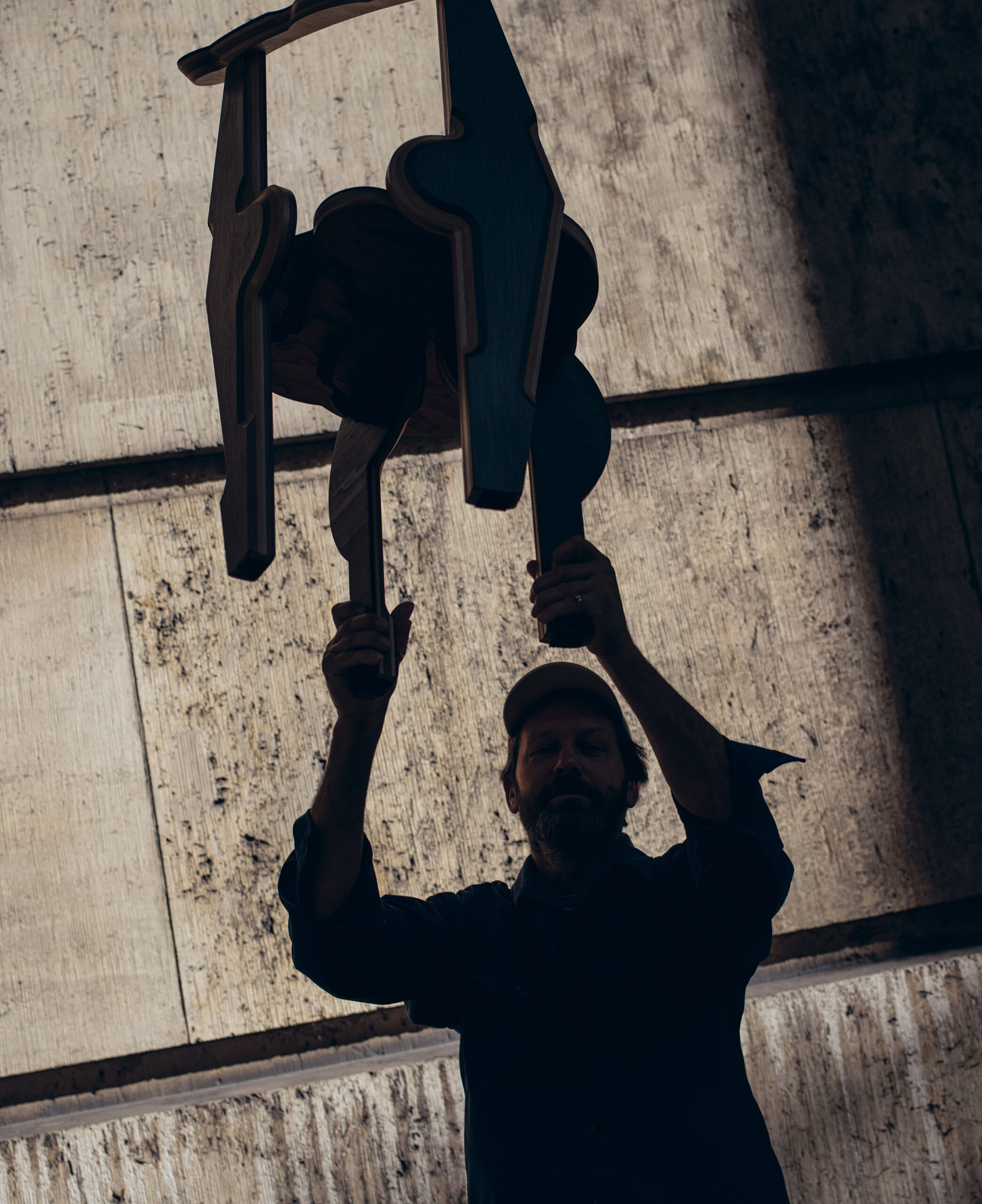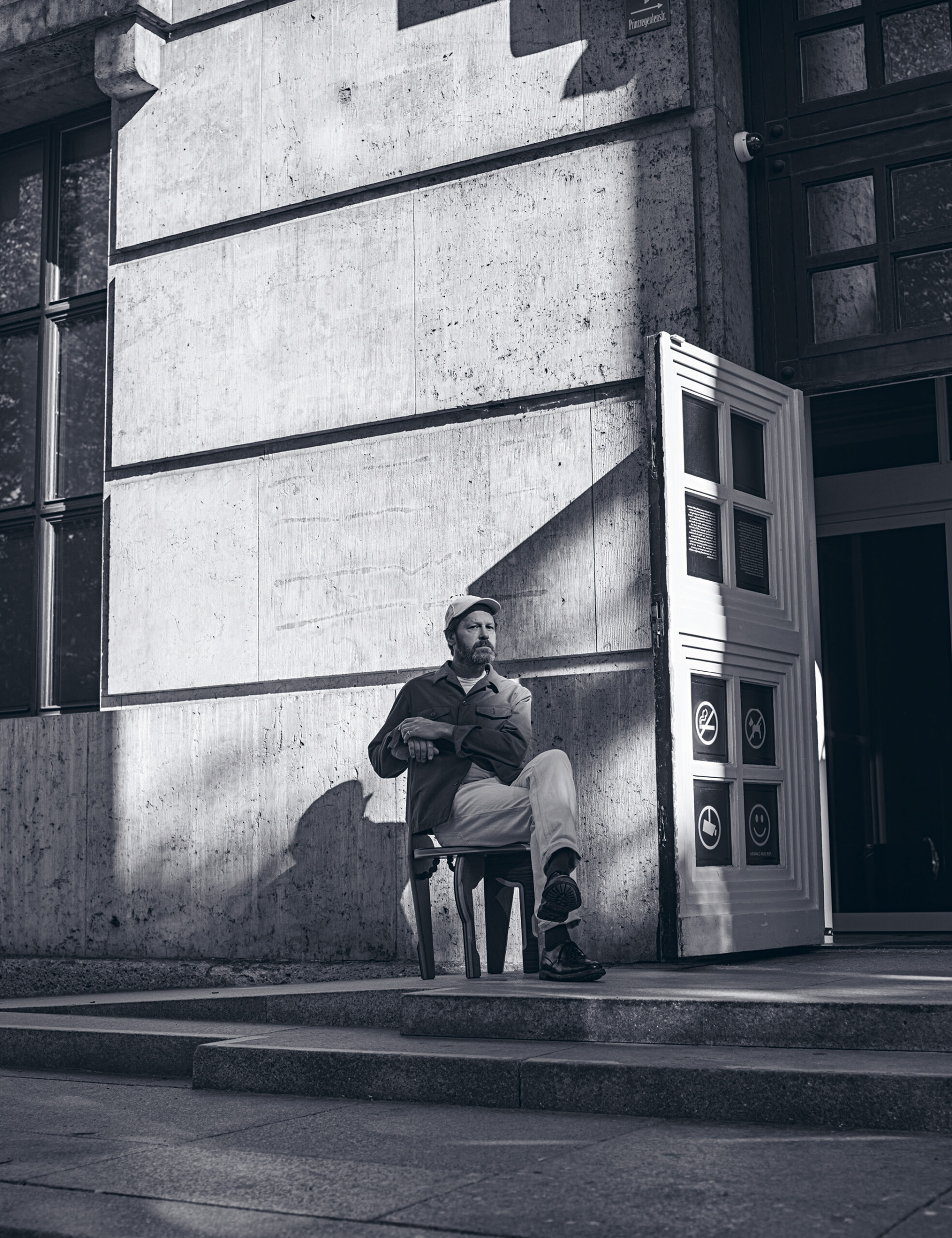
London-based Italian designer Martino Gamper is a shape-shifter, a reassembler, a blurrer of boundaries, a visionary. Making objects that range from utilitarian to unique and collectible, he exhibits in both the design and art worlds. But in whatever contexts his objects are seen, perceived and received, Gamper tweaks our perceptions of space and questions how we interact with the things that surround us and with each other. As he says, “My work is about connecting people.”
nomad’s Kimberly Bradley met the designer in Munich’s Haus der Kunst—an exhibition venue at the edge of the city’s English Garden, erected in 1937 to showcase the era’s Third-Reich art—to discuss his newest exhibition, Sitzung. The show’s name is a play on the German words for both ‘meet’ and ‘sit’, and here Gamper has filled the space’s imposing red-marble Mittelhalle atrium with intriguingly striated multicoloured chairs made with his team in an on-site workshop. The ensemble of seats is meant to be used by the public: sat upon, moved around and played with as an ongoing and welcoming social sculpture.
During the conversation, visitors come through and rest, sit, talk and even eat, then move on. The result of years of conversations brewing between Gamper and Haus der Kunst director Andrea Lissoni, Sitzung is in no small part about shifting the role of the contemporary museum into that of a meeting-place. But the designer has plenty of other thoughts about making, creativity, current and future forms of intelligence, doubt and the irreplaceable power of ‘maybe’.


How many chairs are in this atrium?
M
G
Eighty-nine, I think. They were all made here in the museum. You can see that this week the chairs are in a spiral. If chairs somehow symbolise people in a room, they also tell a story about how to sit in a room. So we decided that every week we’d do a new configuration of chairs. For me, this symbolises how people potentially meet. But what’s interesting is that people move the chairs around.
-
-
-
-
They’re beautiful, as chairs and as objects.
M
G
The material is from a company I work with that makes veneer in Italy. When they produce veneer, there are leftovers at the top and the bottom of the block that they slice, which would normally be burned. This is what we’re using. It enables me to use material that people can’t quite place—it doesn’t exist otherwise. And it’s got very strong graphics. We laminate it together in all different compositions. There are nineteen designs, but each chair is unique. They offer endless combinations.
-
-
-
-
What’s your favourite part about how Sitzung works?
M
G
For once, people are coming to a place to sit down and contemplate. We need that kind of space to be. In the old days it would have been a church.
-
-
-
-
Museums are secular churches, in a way.
M
G
Yeah. I’ve seen people sit down, look at the artwork or just look into space; there’s nothing in the way. When people start moving things around, it’s nice to see that they want to create their own installation. It’s their way of being part of something.
(We go to rooms in the back of the museum, inaccessible to the public, where a series of chairs is being made by Gamper’s team—today, that’s Jesse, Will and Francesco. Chairs in brightly coloured veneer are lined up on tables and the floor, in various states of completion.)
-
-
-
-
More chairs! So you add chairs to Sitzung as it runs?
M
G
Yes, 89 was the first drop. The second now is around 20, and we’ll make more in November. These are our new chairs, made with leftovers from a Konstantin Grcic production with some colourful veneer. And once a month we have a performance: ten of us perform the act of bringing the new chairs into the room.
-
-
-
-
Now that we’re in the workshop, I have philosophical questions: does, or could, a chair possess a certain intelligence?
M
G
It might, but it definitely does not have consciousness. Design creates consciousness, though … a chair creates consciousness. We live with chairs and we use their shapes, and a story is told. But in terms of intelligence and consciousness, you can see and feel whether a chair has been cleverly designed or executed—or not. Some badly designed chairs don’t have much character. When I did my 100 Chairs in 100 Days project (in 2006, Gamper collected disused and discarded chairs and recrafted them into new chairs, one a day, for 100 days. The works have been widely exhibited in art and design venues), I could sense that some chairs had very little to give. They were poorly designed, and poorly made in materials that felt like they wouldn’t last through time. But if you look at the Thonet chair over there (points), you can sense it will be around for a long time. A lot of chairs create tension as an object: they have two, three, four legs and there’s a tension within the shape. Sometimes a very plain and simple chair has less tension, I think.
-
-
-
-
Is more tension more intelligent? I think of the old chairs you see in the Alps with two pieces of wood in an X shape; the balancing piece in the back cuts through the back rest and is also the chair’s seat. They’re rough and rustic and incredibly reduced, but there is a lot of tension in them. Somehow they always seem so brilliant to me.
M
G
And anyone can make them. What (Michael) Thonet did was the opposite, and very clever: it was to actually create a whole factory around the chair.
Please select an offer and read the Complete Article Issue No 15 Subscriptions
Already Customer? Please login.
